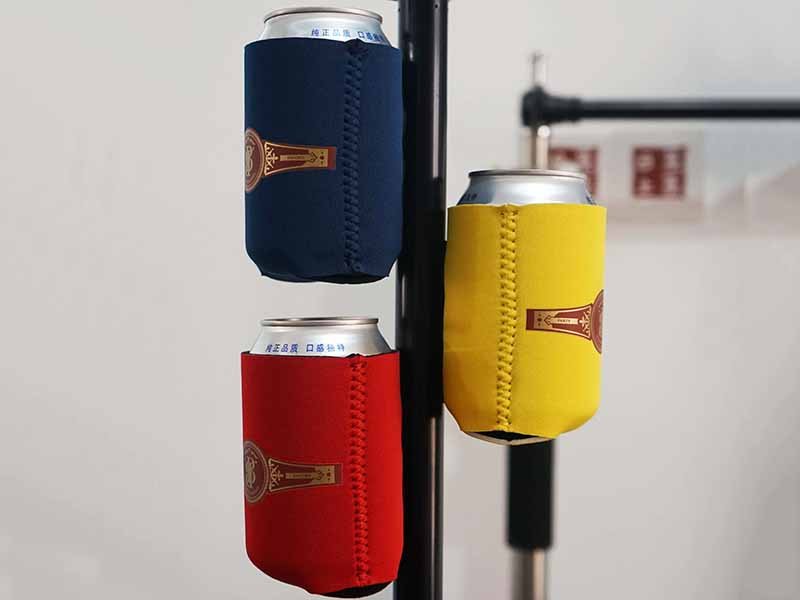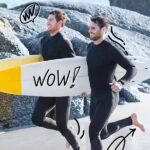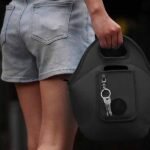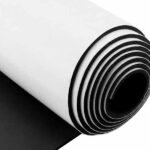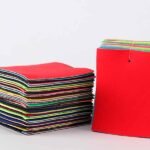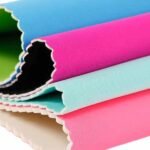Magnetic koozies aren’t just drink sleeves with a twist—they’ve become a practical, brandable accessory for tailgating, boating, camping, and promotional giveaways. Instead of setting your drink down on a dirty surface or holding it in your hand, a magnetic koozie sticks to any metal surface—car doors, toolboxes, boat rails—keeping your drink upright and cold.
To make magnetic koozies, choose 3–5mm neoprene, use N42 or N52 neodymium magnets with anti-rust coatings, integrate magnets into reinforced sleeves, apply heat transfer or sublimation printing for branding, and conduct holding force, durability, and compliance tests before mass production.
And here’s the best part: the technology behind these products is simple yet sophisticated. This guide will show you the materials, magnet choices, structural design, production workflow, and testing standards manufacturers like Szoneier use to create high-performance custom magnetic koozies for brands worldwide.
Let’s start by breaking down what a magnetic koozie really is and the core materials you need before heading into design and manufacturing details.
What Is a Magnetic Koozie and How Does It Work?
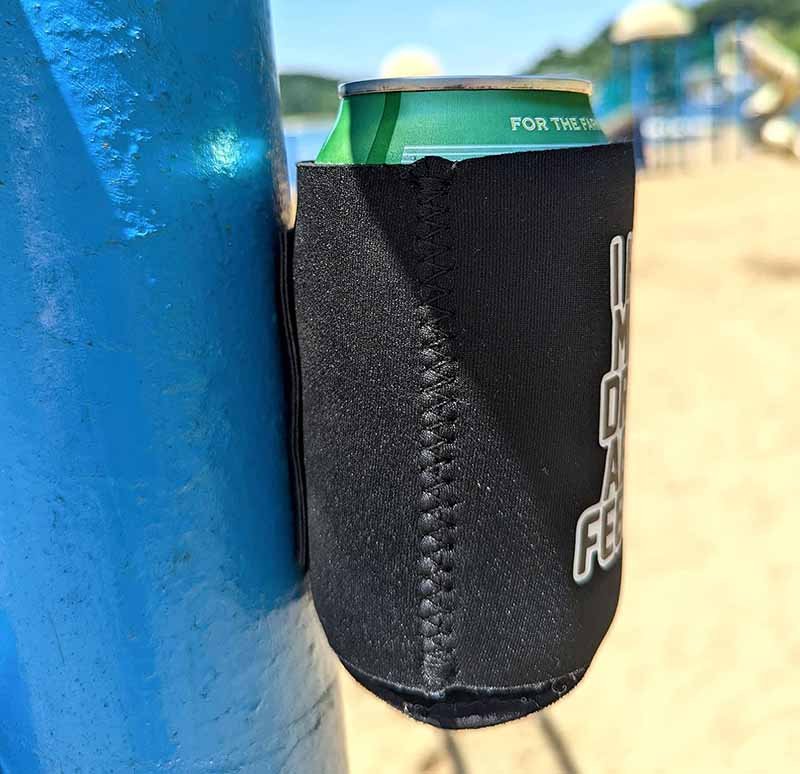
A magnetic koozie is a neoprene or foam drink sleeve with embedded magnets that lets you stick your drink to any steel surface. It combines thermal insulation with magnetic holding power so your drink stays cold, secure, and hands-free.
What Problems do Magnetic Koozies Solve For Tailgating, Boating, and Workshops?
Magnetic koozies solve three big problems:
- Convenience – No flat surface? Stick it to your car or boat railing.
- Temperature retention – Neoprene insulation keeps drinks cold longer.
- Hands-free safety – Reduces spills in moving environments like boats or tailgates.
In workshops, they attach to toolboxes. On boats, they secure drinks against rocking waves. At tailgates, they free your hands for games or grilling.
How do Magnets, Foam/Neoprene, and Fabric Layers Interact to Hold a Can Securely?
A magnetic koozie combines three key elements:
- Neoprene/Foam Layer: Provides insulation and flexibility.
- Embedded Magnets: Offer holding strength on steel surfaces.
- Outer Fabric Lamination: Polyester or jersey fabric creates a smooth surface for printing and branding.
When designed correctly, the magnet placement and fabric stretch distribute the holding force evenly across the can’s surface, preventing sliding or tipping.
Which Can/Bottle Sizes (12oz, 16oz, slim) Are Easiest To Engineer First?
Most manufacturers start with 12oz standard cans because:
- They are the most common beverage size in the U.S. market.
- Require fewer magnets (typically 3–4).
- Lower risk of weight imbalance compared to tall slim cans or heavy 16oz bottles.
Once the 12oz design is tested, it’s easy to scale patterns for slim or larger cans by adjusting diameter and height dimensions.
Which Materials and Magnet Grades Should You Choose?
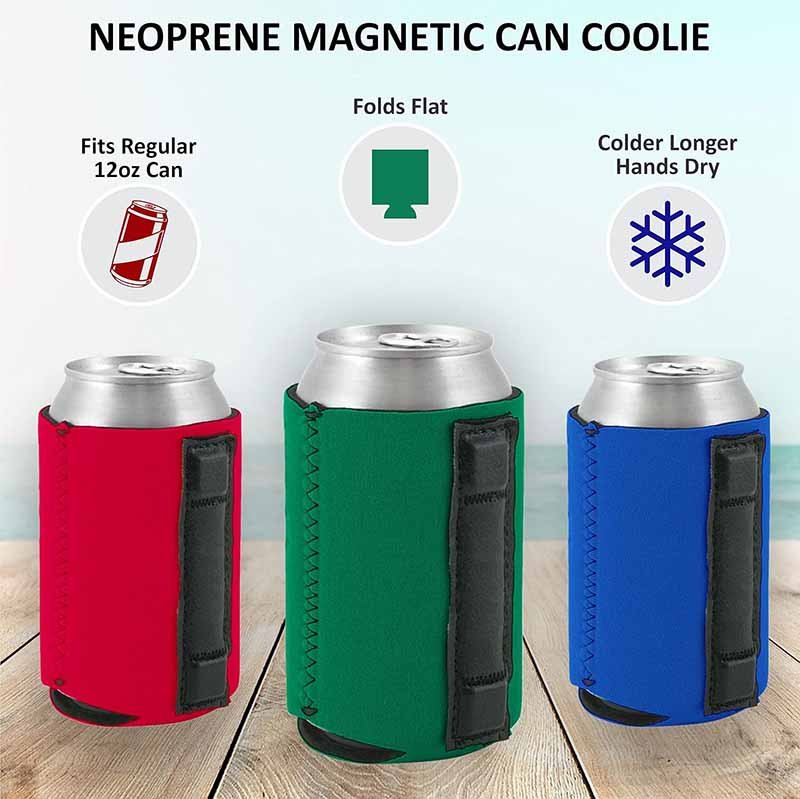
Use 3–5mm neoprene, N42/N52 neodymium magnets, and epoxy or rubber coatings for durability. Outer laminations like polyester improve print quality and wear resistance.
What Neoprene Thickness (3mm vs 4mm vs 5mm) Balances Insulation and Grip?
| Thickness | Flexibility | Insulation | Typical Use Case |
|---|---|---|---|
| 3mm | High | Moderate | Budget koozies, lightweight cans |
| 4mm | Balanced | Good | Most retail & promo koozies |
| 5mm | Lower | Best | Premium, heavy-duty environments |
- 3mm → Easy to fold, cheaper, less insulation.
- 4mm → Best balance for grip + insulation + cost.
- 5mm → Used for outdoor/marine brands needing extra durability.
Which Magnet Types (N35/N42/N52 Neodymium, Ferrite) Perform Best and Why?
| Magnet Grade | Pull Strength | Cost | Best Application |
|---|---|---|---|
| N35 | Standard | Low | Light cans, budget promos |
| N42 | High | Medium | Balanced cost-performance option |
| N52 | Very High | Higher | Heavy bottles, marine/outdoor environments |
| Ferrite | Low | Very Low | Rarely used due to bulk & low strength |
N42 is the industry standard: affordable, strong, easy to source. N52 is for premium brands or heavy-duty holding power.
What Coatings (NiCuNi, Epoxy, Rubberized) Prevent Rust and Edge Chipping?
| Coating Type | Corrosion Resistance | Durability | Cost | Environment |
|---|---|---|---|---|
| NiCuNi (Nickel) | Good | Moderate | Low | Standard indoor use |
| Epoxy | Excellent | High | Medium | Marine/outdoor use |
| Rubberized | Excellent | High | Higher | Heavy-duty, impact |
For boats, beaches, and humid areas, epoxy-coated magnets outperform NiCuNi by 2–3x in salt-spray tests.
Are Fabric Laminations (Polyester, Jersey, Scuba) Better for Print Clarity and Durability?
| Fabric Type | Print Clarity | Durability | Cost | Feel |
|---|---|---|---|---|
| Polyester | High | High | Low | Smooth, common choice |
| Jersey | Medium | Moderate | Low | Soft, casual look |
| Scuba Knit | Very High | Very High | Higher | Premium, structured |
For retail-grade branding, polyester or scuba knit laminations ensure vivid logos and longer wear resistance.
How Do You Design The Structure For Strength And Safety?
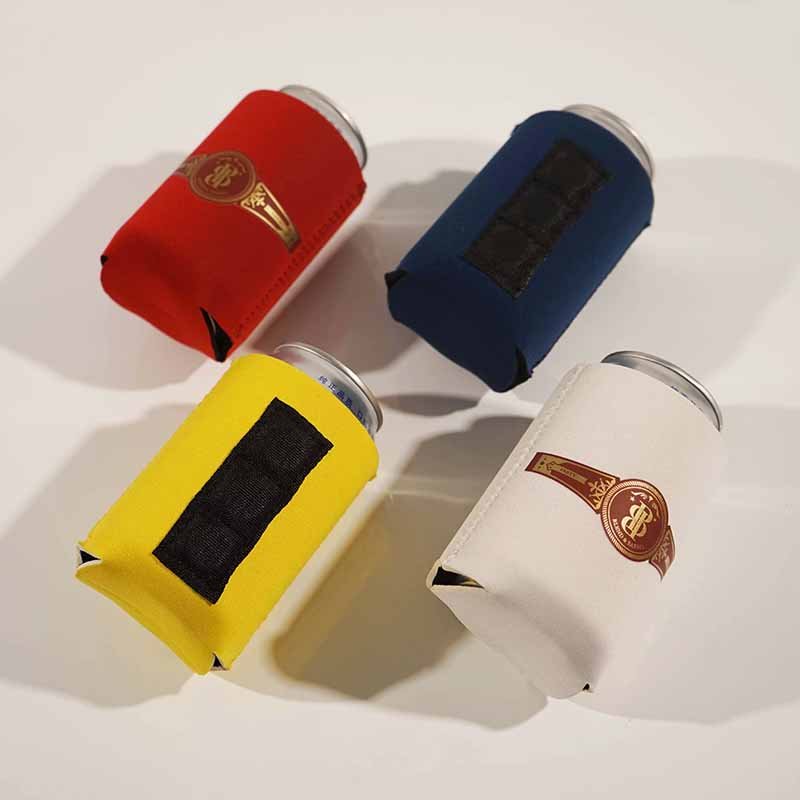
To design a magnetic koozie for strength and safety, use 3–4 evenly spaced magnets, reinforce seams with bar-tack or zigzag stitching, and choose grid or horseshoe layouts to prevent tipping. Add edge sealing for user safety and durability.
How Many Magnets Per Koozie—And Where—Optimize Holding Force Without Bulk?
Most 12oz koozies use 3–4 neodymium magnets with a holding force of 1–2 lbs each.
- 3 Magnets → Light cans, cost-efficient promos.
- 4 Magnets → Heavy cans, boats, tailgating conditions.
Strategic placement prevents the koozie from sliding down vertical surfaces under weight or condensation.
Which Placements (Vertical Strip, Staggered Grid, Horseshoe) Reduce Tilt And Slip?
| Layout Type | Pros | Cons | Best Use Case |
|---|---|---|---|
| Vertical Strip | Easy to produce | Less lateral stability | Budget koozies, basic use |
| Staggered Grid | Even weight distribution | Slightly higher cost | Premium retail, marine environments |
| Horseshoe Layout | High holding power at edges | Complex stitching | Heavy bottles, moving vehicles |
Grid layouts perform best in drop and peel tests because magnets support the can’s center of gravity evenly.
Do You Need A Magnetic Shield Or Backing Plate To Avoid Pinch Points?
- Yes, for safety-critical designs: Thin PP backing plates or laminated fabric layers cover magnets to prevent pinch injuries.
- Shields also improve comfort by creating a smoother surface for hands.
- CPSIA guidelines recommend child-safe magnet encapsulation for consumer products.
What Seam Styles (Blind Stitch, Zigzag, Flatlock) Resist Peel When Magnets Pull?
| Seam Type | Strength | Flexibility | Cost | Recommended For |
|---|---|---|---|---|
| Blind Stitch | Low | High | Low | Budget, low-tension products |
| Zigzag Stitch | Medium | Medium | Medium | Standard retail-grade koozies |
| Bar-Tack Stitch | Very High | Moderate | Higher | Heavy-duty, marine applications |
| Flatlock Stitch | High | Low | Higher | Premium aesthetics, tight seams |
For outdoor brands, bar-tack reinforcement at magnet pockets reduces seam failure by 40% vs zigzag stitching in long-term usage tests.
How Are Magnets Integrated During Production?
Magnets are inserted into fabric pockets or sleeves, bonded with PU hot-melt adhesives, aligned using production jigs, and secured with bar-tack reinforcement before final stitching and branding.
How To Make Pockets Or “Sleeves” To Encapsulate Magnets Before Stitching?
Manufacturers create small fabric compartments inside the koozie’s inner layer:
- Cut neoprene panels to size.
- Heat-seal or stitch sleeves for magnets.
- Insert pre-coated magnets before final assembly.
- Bar-tack reinforcement seals each sleeve to prevent shifting.
This ensures magnets stay in place even after 50+ wash cycles or repeated impacts.
Which Adhesives (PU Hot-Melt, Contact Cement, PSA Tapes) Bond To Neoprene Reliably?
| Adhesive Type | Bond Strength | Heat Resistance | Cost | Application Method |
|---|---|---|---|---|
| PU Hot-Melt Glue | High | High (120°C) | Medium | Industrial spray or roll-on |
| Contact Cement | Very High | Moderate (80°C) | Low | Manual brush/roller |
| PSA Tapes | Medium | Low (60°C) | Low | Peel-and-stick lining |
PU hot-melt adhesives provide best bonding with automated spray systems for high-volume production lines.
Is Heat-Press Lamination Or Bar-Tack Reinforcement Necessary For Impact Zones?
Yes. For marine, camping, or automotive products exposed to shocks and impacts:
- Heat-press lamination adds secondary bonding strength.
- Bar-tack stitching prevents peeling forces when magnets snap onto surfaces.
Tests show 20–30% higher seam durability with bar-tack vs zigzag in impact conditions.
How To Keep Magnets Aligned During Cutting, Sewing, And Curing?
Factories use magnet alignment jigs:
- Precision templates ensure consistent spacing.
- Automated placement prevents polarity errors (all magnets facing the same way).
- Alignment reduces assembly time by 25% in mass production.
What Printing & Branding Methods Work Best On Magnetic Koozies?
Use heat transfer or sublimation printing for full-color designs, screen printing for simple logos, and silicone ink for premium, textured finishes on magnetic koozies.
Which To Choose: Screen Printing, Heat Transfer, Sublimation, Or Silicone Ink?
| Printing Method | Print Quality | Cost | Durability | Best For |
|---|---|---|---|---|
| Screen Printing | Medium | Low | Moderate | One/two-color promo koozies |
| Heat Transfer Printing | High | Medium | High | Multi-color brand logos |
| Sublimation Printing | Very High | Medium | Very High | Full-wrap retail-grade designs |
| Silicone Ink Printing | High (3D Effect) | Higher | Very High | Premium textured branding |
For premium retail products, sublimation offers photo-realistic designs that last 50+ wash cycles without fading.
How Do Ink Systems Withstand Condensation, Abrasion, And UV?
- Condensation Resistance: Heat-transfer and sublimation inks penetrate fabric layers, resisting peeling from moisture.
- Abrasion Resistance: Silicone inks provide textured surfaces with high rub tolerance.
- UV Protection: Outdoor-grade inks prevent color fading up to 1,000 hours of sun exposure.
Are Pantone-Matched Edge Bindings, Woven Labels, Or Zipper Pulls Worth Adding?
Yes, for brand consistency and retail appeal:
- Pantone-matched edge bindings align colors with corporate branding.
- Woven labels add a premium, stitched look.
- Zipper pulls or hang tags create retail-ready packaging options.
How Do You Test Holding Force, Durability, And Safety?
Magnetic koozies undergo drop tests, shear/peel strength tests, salt-spray corrosion tests, and UV/weathering tests to ensure magnet retention, fabric durability, and long-term performance before mass production.
What Drop, Shear, And Peel Tests Validate Magnet Retention On Steel Surfaces?
| Test Type | Purpose | Standard | Pass Criteria |
|---|---|---|---|
| Drop Test | Impact resistance on hard surfaces | ASTM D5276 | No seam tears or magnet detachment |
| Shear Strength Test | Magnet sliding resistance | ASTM D1002 | > 1.5 lbs hold on vertical steel panel |
| Peel Strength Test | Adhesive bonding durability | ASTM D903 | > 2 lbs peel resistance |
For marine or automotive brands, shear strength ≥ 2.0 lbs is recommended for vertical holding on moving vehicles or boats.
Which Environmental Tests (Salt-Spray, Humidity, Freezer/Heat Cycling) Matter?
- Salt-Spray Corrosion Test: 96-hour exposure simulating coastal environments.
- Humidity Test: 90% RH at 40°C for 48 hours checks mold/mildew resistance.
- Freezer/Heat Cycling: -20°C to 70°C cycles test adhesive bonding stability.
- UV Exposure: 1,000-hour sunlight simulation for colorfastness testing.
Epoxy-coated magnets withstood salt-spray corrosion 3x longer than standard NiCuNi coatings.
Do Magnets Interfere With Electronics Or Pose Safety Concerns—How To Mitigate?
- Electronic Interference: Low risk because small neodymium magnets lack sufficient field strength to disrupt electronics beyond 2–3 cm.
- Pinch Hazards: Rounded magnet edges and laminated safety covers reduce injury risk.
- Child Safety: Follow CPSIA standards for encapsulating magnets in consumer products.
Are There Compliance, Packaging, And Shipping Considerations?
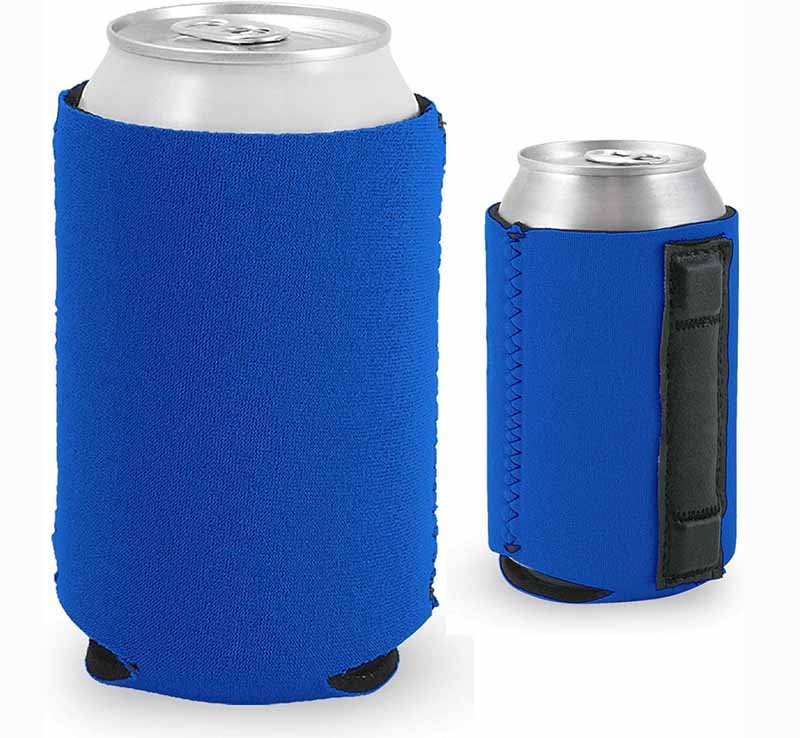
Yes. Magnetic koozies must meet REACH, CPSIA, and RoHS material standards, include safety labeling, and follow air freight shielding regulations for strong magnets to prevent cargo interference.
What Chemical And Physical Standards Should The Materials Meet (E.G., REACH, CPSIA)?
| Standard | Region | Requirement Focus | Relevance To Koozies |
|---|---|---|---|
| REACH | EU | Chemical safety compliance | Fabric dyes, adhesives, coatings |
| CPSIA | USA | Child product safety | Magnet encapsulation, labeling |
| RoHS | EU/Global | Restriction of heavy metals | Coating materials, inks |
| ISO 9001 | Global | Quality Management Systems | Production process control |
How To Label Magnet Warnings And Care Instructions For Retail?
- Magnet Safety Icons: “Keep Away From Children” warnings on packaging.
- Care Instructions: Washing guidelines for heat-transfer or sublimation prints.
- Retail Labels: UPC barcodes, QR codes for brand websites or promotions.
Which Packaging Formats (OPP Sleeve, Hang Tag, Gift Box) Protect Alignment In Transit?
| Packaging Type | Cost | Protection Level | Retail Readiness |
|---|---|---|---|
| OPP Poly Sleeves | Low | Low | Bulk shipping, promos |
| Hang Tags | Low | Moderate | Mid-tier retail products |
| Gift Boxes | Higher | High | Premium retail products |
Are Air Shipments Affected By Strong Magnets—What Shielding Or Spacing Is Required?
- IATA Guidelines: Magnets above certain Gauss levels need shielding.
- Use steel-lined shipping boxes to reduce detectable magnetic fields.
- Spacing cartons >15 cm apart prevents field interference across pallets.
How To Scale From Prototype To Mass Production With Szoneier?
Szoneier offers DFM support, rapid prototyping, low MOQs, custom branding, and strict QC processes, ensuring magnetic koozies scale smoothly from sample to full production with global compliance certification.
What Is The Typical Sampling Workflow (DFM → Proto → Pilot → PP Sample)?
| Stage | Lead Time | Purpose | Output |
|---|---|---|---|
| DFM (Design) | 3–5 Days | CAD design & material selection | Tech pack, cost estimates |
| Prototype | 7–10 Days | First physical sample for approval | Functional prototype |
| Pilot Run | 2–3 Weeks | Small batch to test production flow | Pilot batch, QC feedback |
| PP Sample | 1 Week | Final pre-production approval | Golden sample for mass production |
Which MOQs, Lead Times, And QC Checkpoints Keep Projects On Schedule?
- MOQ: 500–1,000 pcs per design for most custom programs.
- Lead Time: 30–40 days for standard orders, faster with air freight.
- QC Checkpoints: Incoming material checks, in-line stitching audits, final AQL inspections.
How Do We Customize Sizes, Magnet Layouts, And Print Files For Brand Programs?
- Sizes: 12oz standard → 16oz tallboys → slim seltzer cans.
- Magnet Layouts: Vertical vs grid vs horseshoe options.
- Print Files: Accept AI, PSD, EPS for full-color sublimation graphics.
What Cost Levers (Magnet Grade, Count, Thickness, Print Method) Optimize Price Without Sacrificing Performance?
| Cost Lever | Impact On Cost | Impact On Performance | Recommendation |
|---|---|---|---|
| Magnet Grade | High | Holding strength | Use N42 unless heavy-duty needed |
| Magnet Count | Medium | Stability vs cost trade-off | 3 magnets for light cans, 4 for heavy |
| Neoprene Thickness | Medium | Insulation & durability | 4mm standard for balance |
| Printing Method | Low–Medium | Branding quality | Sublimation for premium, screen for promos |
Frequently Asked Questions
- What Magnet Strength Is Recommended For A 12oz Can? → N42 magnets with 1.5–2 lbs pull force each.
- Can Magnetic Koozies Hold Drinks On Moving Vehicles? → Yes, if using 4 N52 magnets with reinforced stitching.
- Which Printing Method Lasts Longest In Outdoor Conditions? → Sublimation printing offers best UV and wash resistance.
- Are Magnetic Koozies Dishwasher Safe? → Hand-wash recommended to protect adhesives and prints.
- What Is The Minimum Order Quantity (MOQ)? → 500–1,000 pcs depending on customization complexity.
- Do Magnets Affect Smartphones Or Credit Cards? → Only at close contact (<2 cm). Retail products meet consumer safety guidelines.
- How Long Is The Sampling Lead Time? → 7–10 days for first prototypes.
- What Is The Standard Production Lead Time? → 30–40 days after sample approval.
- Can We Customize Packaging For Retail Chains? → Yes, including hang tags, gift boxes, QR codes.
- Does Szoneier Offer Private Label Branding? → Yes, with OEM/ODM customization services worldwide.
Conclusion: Partner With Szoneier For Custom Magnetic Koozies
With 18+ years of OEM/ODM experience, Szoneier provides full-service magnetic koozie manufacturing:
- Material sourcing & magnet integration expertise
- Custom branding & packaging solutions
- Rapid sampling & low MOQs for global brands
- ISO9001, REACH, CPSIA compliance for export markets
Whether you need tailgating promos, marine accessories, or premium retail koozies, Szoneier ensures quality, speed, and competitive pricing.

